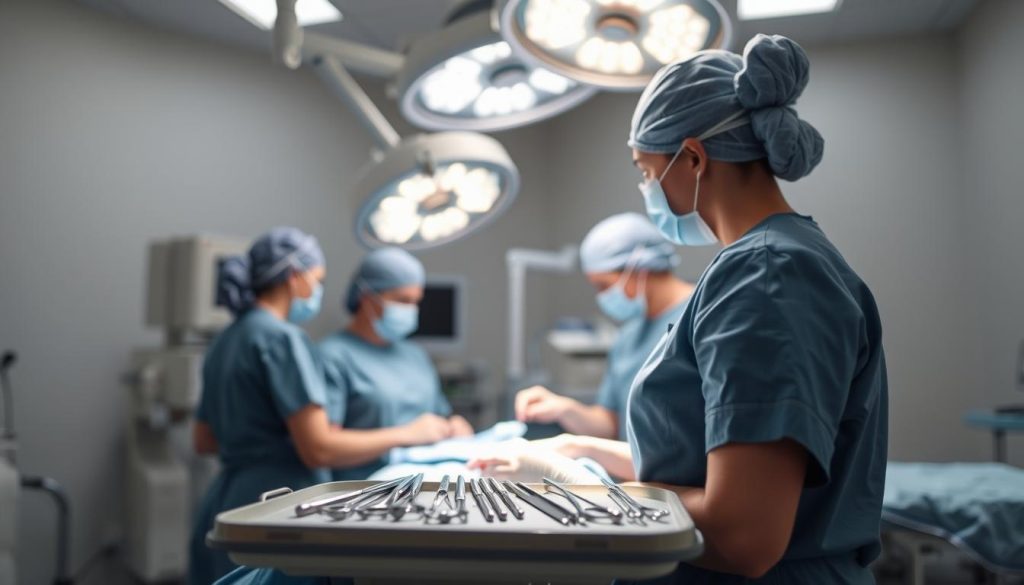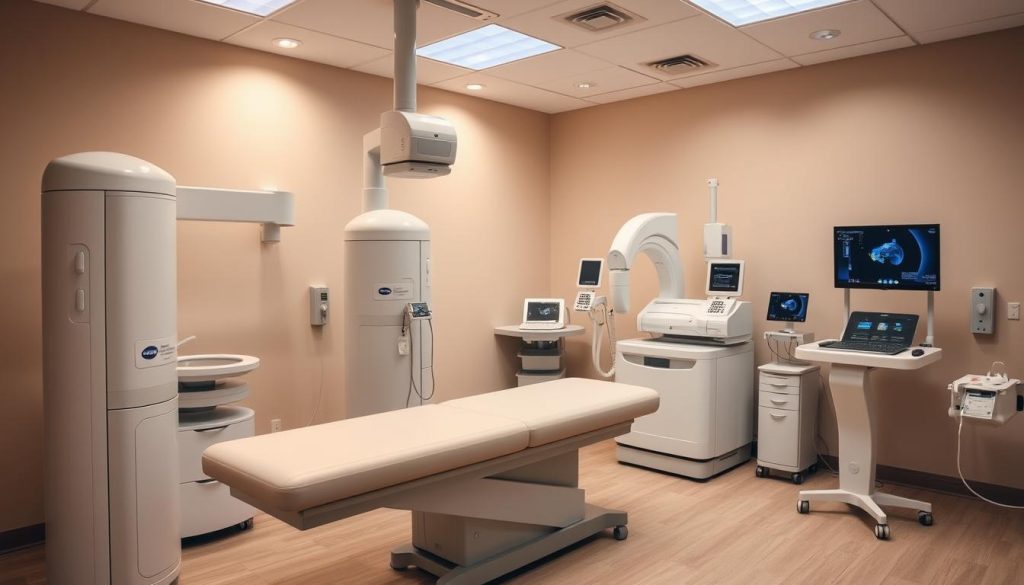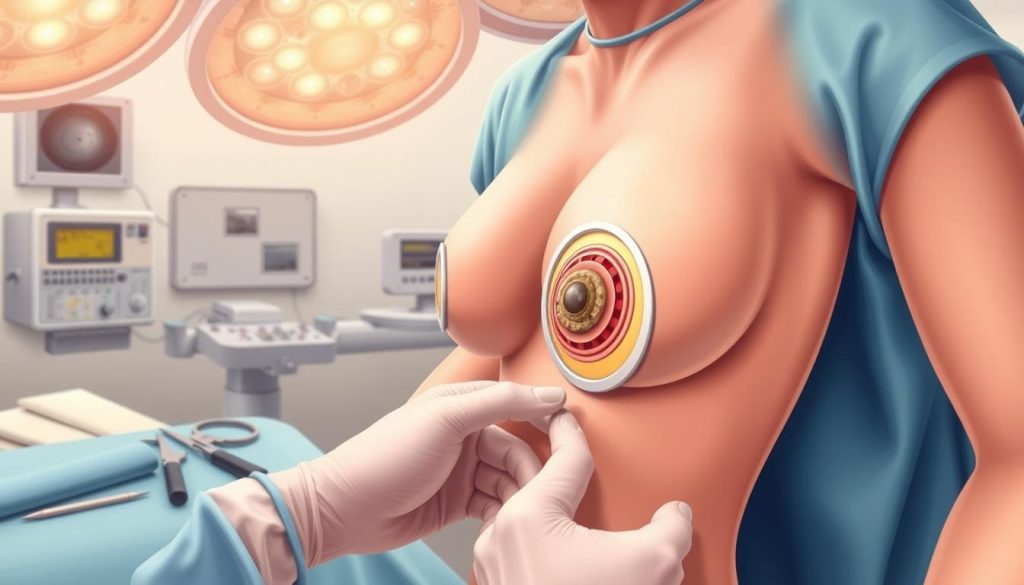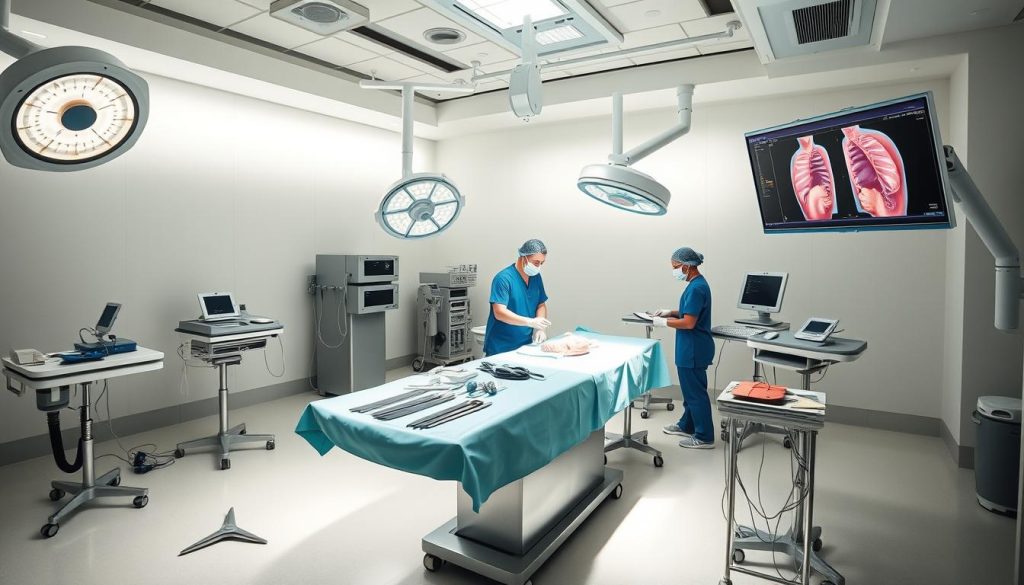Getting a breast cancer diagnosis can feel scary. But, lumpectomy surgery offers hope. It removes the tumor and keeps most of the breast tissue.
Lumpectomy is a key part of treating breast cancer. It helps women keep their natural breast shape while fighting cancer. This method is often less invasive, leading to faster recovery times than bigger surgeries.
Learning about lumpectomy helps patients make better choices. Knowing about the surgery, recovery, and follow-up care is important. It’s all part of fighting breast cancer.
What Is Lumpectomy Surgery: A Comprehensive Overview
Lumpectomy surgery is a main treatment for breast cancer. It removes the tumor but keeps the healthy breast tissue. Let’s look at the basics of this surgery and its benefits.
Definition and Basic Principles
A lumpectomy is a surgery that takes out cancerous tissue from the breast. Surgeons aim to remove the tumor and a bit of healthy tissue around it. This helps keep the breast’s shape and function.

Difference Between Lumpectomy and Mastectomy
Both procedures treat breast cancer, but they’re different:
- Lumpectomy: Removes only the tumor and some surrounding tissue
- Mastectomy: Removes the entire breast
Lumpectomy is less invasive and often preferred. It lets women keep most of their breast tissue.
Key Benefits of Breast-Conserving Surgery
Breast-conserving surgery has many advantages:
- Shorter recovery time
- Less impact on body image
- Comparable survival rates to mastectomy for early-stage cancers
- Preservation of breast sensation
These benefits make lumpectomy a good choice for many. It offers effective treatment while considering quality of life.
When Doctors Recommend Breast-Conserving Surgery
Doctors look at many things when choosing a treatment for breast cancer. They often suggest lumpectomy, a surgery that saves as much of the breast as possible. This method aims to remove the tumor while keeping healthy tissue.
Early-stage breast cancers are often treated with lumpectomy. Tumors under 5 centimeters usually do well with this treatment. The tumor’s location is also key. It should be in an area where removing it won’t change the breast’s look too much.
What the patient wants is also important. Some women choose lumpectomy to keep their breast shape. Others might pick mastectomy to avoid radiation or for other reasons.
| Factor | Favorable for Lumpectomy | Less Favorable |
|---|---|---|
| Cancer Stage | Early stages (0, I, II) | Advanced stages (III, IV) |
| Tumor Size | Less than 5 cm | Larger than 5 cm |
| Tumor Location | Easily accessible | Multiple areas or near chest wall |
| Breast Size | Medium to large | Very small |
Lumpectomy isn’t right for everyone. It’s not good for tumors that are big, in many places, or for inflammatory breast cancer. Your doctor will help find the best treatment for you.
Types of Breast Tumors Suitable for Lumpectomy
Lumpectomy is a surgery that saves most of the breast when treating certain cancers. It removes the tumor while keeping the rest of the breast tissue. Let’s look at the types of breast tumors that work well with this method.
Invasive Breast Cancer Cases
Invasive breast cancer can spread beyond the milk ducts or lobules. It can often be treated with lumpectomy. This includes invasive ductal and lobular carcinomas. The success of the surgery depends on the tumor’s size and where it is located.
Ductal Carcinoma In Situ (DCIS)
DCIS is a non-invasive cancer that stays in the milk ducts. It’s often treated with lumpectomy. This method is precise and effective. It’s often paired with radiation to lower the chance of cancer coming back.
Size and Location Considerations
The size of the tumor and the breast matter a lot for lumpectomy. Tumors under 5 cm are usually okay for this surgery. Where the tumor is also plays a big role. Tumors near the chest wall or spread out in the breast might not be good for lumpectomy.
- Tumor size: Typically less than 5 cm
- Single tumor preferred
- Clear margins achievable
- Breast size adequate to maintain shape post-surgery
Your oncologist will check these things to see if lumpectomy is right for you. The aim is to remove the tumor completely and keep the breast looking natural.
Pre-Surgery Evaluation and Testing
Before lumpectomy surgery, patients undergo a detailed evaluation. This step is key to a successful breast cancer treatment.

- Mammograms
- Ultrasounds
- MRIs
These tests help doctors find the tumor’s exact location and size. They also check for any other unusual areas in the breast.
A biopsy is done to confirm the cancer diagnosis and type. It involves taking a small tissue sample for lab tests.
Patients talk with their surgical team about the surgery. Doctors explain the procedure, risks, and what to expect. They also answer any questions or concerns.
“Pre-surgery evaluation is vital for a personalized treatment plan. It gives the best chance of success.”
The medical team uses test results and consultations to create a custom treatment plan. This plan might include extra therapies like radiation or chemotherapy after surgery.
Doctors carefully review each case to make sure lumpectomy is the right choice for the patient.
The Lumpectomy Surgical Procedure Step by Step
Lumpectomy is a precise surgical technique for breast cancer treatment. It aims to remove the tumor while keeping healthy breast tissue. Let’s explore the key steps involved in this life-saving operation.
Anesthesia Administration
The surgery starts with the anesthesiologist giving general anesthesia. This keeps the patient asleep and pain-free. Once the anesthesia works, the surgical team gets ready to work on the breast.
Incision and Tumor Removal
The surgeon makes a small incision in the breast, finding the tumor. They use special tools to remove the tumor and some healthy tissue around it. This helps make sure all cancer cells are gone.

Margin Assessment
After removing the tumor, the team checks the margins. They look at the tissue to see if all cancer cells are out. If not, they might take more tissue to make sure.
Surgical Closure Techniques
After the tumor is removed and margins are clear, the surgeon closes the incision. They use new methods to reduce scarring and keep the breast’s shape. This includes stitches that dissolve and skin adhesives for a smooth finish.
Knowing these steps can help patients feel more ready and confident for their lumpectomy surgery. The procedure’s precision and focus on saving the breast make it a great choice for many breast cancer patients.
Lymph Node Dissection During Surgery
Lymph node dissection is key in treating breast cancer. It involves removing lymph nodes near the tumor to check for cancer spread. Surgeons do two main types: sentinel node biopsy and axillary lymph node dissection.
Sentinel node biopsy targets the first lymph nodes where cancer might spread. Doctors inject a dye or radioactive substance near the tumor. They then remove the nodes that absorb this material. If these nodes are cancer-free, more lymph node removal may not be needed.
Axillary lymph node dissection removes more lymph nodes from the armpit area. This helps determine the cancer stage and guides treatment decisions. Recent studies show that extensive lymph node surgery may not always be needed for early-stage breast cancer patients.
| Procedure | Nodes Removed | Recovery Time |
|---|---|---|
| Sentinel Node Biopsy | 1-5 | 1-2 weeks |
| Axillary Lymph Node Dissection | 10-40 | 3-4 weeks |
Lymph node dissection can affect a patient’s recovery and long-term health. Side effects include lymphedema, arm numbness, and reduced range of motion. Doctors consider these risks against the benefits of accurate cancer staging and treatment planning.
Recovery Timeline After Breast-Conserving Surgery
Knowing how long it takes to recover from a lumpectomy is key. The healing time can vary. But, knowing what to expect can help ease worries and make recovery smoother.
Immediate Post-Operative Period
Right after surgery, patients usually spend a few hours in the recovery room. They start getting pain relief and have their vital signs checked. Most go home the same day, with instructions on care and pain meds.
First Week Recovery
The first week is very important for healing. Patients often feel:
- Soreness and swelling around the incision site
- Fatigue from anesthesia and surgery
- Limited arm movement on the affected side
Rest is important, but gentle arm exercises can help avoid stiffness. Keeping the wound clean and dry is part of wound care.
Long-Term Healing Process
Full recovery can take several weeks to months. Most women can get back to normal in 2-3 weeks. The incision keeps healing, and any pain left will lessen over time. Regular check-ups with the surgeon are important to make sure everything is healing right.
“Every patient’s recovery time is unique. Listen to your body and follow your doctor’s guidance for the best outcomes.”
Being patient is essential during recovery. With the right care and time, most women heal well and adjust to life after lumpectomy.
Managing Post-Surgery Side Effects
Lumpectomy surgery is less invasive than mastectomy but can cause side effects. Patients need to be ready to handle these symptoms during recovery.
Pain is a common side effect after lumpectomy. Your doctor might give you pain medication or suggest over-the-counter options. Ice packs on the surgical area can help with pain and swelling.
Swelling and bruising around the breast and armpit are normal. Wearing a supportive bra and avoiding hard activities can help. Some patients notice changes in breast sensation or look, which may get better over time.
| Side Effect | Management Strategy |
|---|---|
| Pain | Pain medication, ice packs |
| Swelling | Supportive bra, limited activity |
| Bruising | Ice packs, rest |
| Sensation changes | Time, gentle massage |
Infection is a possible complication. Look out for fever, increased redness, or discharge from the incision site. Call your doctor right away if you see these signs.
Remember, everyone recovers differently. If you’re worried about any side effects, talk to your healthcare team for advice.
Follow-up Treatment and Radiation Therapy
After lumpectomy surgery, radiation therapy is key in treating breast cancer. It targets and destroys any leftover cancer cells. This helps lower the chance of cancer coming back.
Scheduling Radiation Sessions
Radiation therapy usually starts 3-8 weeks after surgery. Patients get daily treatments, five days a week, for weeks. The exact schedule depends on the treatment plan and individual factors.
Duration of Treatment
The full radiation therapy course lasts 3-7 weeks. Some might get accelerated partial breast irradiation, done in 5-10 days. Your oncologist will choose the best option for you.
| Treatment Type | Duration | Frequency |
|---|---|---|
| Standard Whole Breast Radiation | 3-7 weeks | 5 days per week |
| Accelerated Partial Breast Irradiation | 5-10 days | Twice daily |
Expected Outcomes
Radiation therapy greatly lowers the risk of cancer coming back in the treated breast. Studies show it’s as good as mastectomy for early-stage breast cancer. Most patients have few side effects and keep their quality of life.
Aesthetic Results and Breast Reconstruction Options
Lumpectomy surgery tries to keep the breast shape while removing cancer. The look of the breast after surgery can change. This depends on the size and where the tumor is.
Many women see little change in how their breast looks after surgery.
Things that affect how the breast looks include:
- How much tissue is removed
- The size of the breast
- The surgical method used
- How well the body heals
Doctors work hard to keep the breasts looking even. They plan the cuts and how much tissue to remove carefully. Sometimes, they suggest breast reconstruction to make the breast look better.
- Fat grafting: Using your own fat to fill in uneven areas
- Tissue flaps: Moving tissue from another part of the body to shape the breast
- Implants: Using silicone or saline implants to add volume
Choosing the right breast reconstruction method depends on many things. These include the size of the breast, the quality of the tissue, and what the woman prefers. Talking to a plastic surgeon can help figure out the best way to get the look you want.
“Breast reconstruction can significantly improve a woman’s self-image and quality of life after lumpectomy surgery.”
New surgical methods are making lumpectomy results look better. With careful planning and skilled surgeons, many women get great results. They get their breasts to look good while also treating their cancer.
Potential Complications and Risk Factors
Lumpectomy surgery is usually safe, but it can cause some side effects. Knowing these helps patients get ready and take steps to prevent them.
Common Complications
Patients might face:
- Infection at the surgical site
- Bleeding or bruising
- Seroma (fluid buildup)
- Changes in breast shape or size
- Numbness or altered sensation
Risk Prevention Strategies
To lessen side effects, patients should:
- Follow post-operative care instructions carefully
- Keep the incision site clean and dry
- Wear a supportive bra as recommended
- Avoid strenuous activities during recovery
- Attend all follow-up appointments
When to Contact Your Doctor
Get medical help right away if you see:
- Fever or chills
- Increased pain, redness, or swelling
- Unusual discharge from the incision
- Severe bleeding
- Difficulty breathing
Being alert and taking action can make recovery smoother and lower the chance of problems.
Long-term Follow-up Care Guidelines
After lumpectomy surgery, it’s key to keep up with post-operative care for long-term health. Patients must stick to a plan to watch their recovery and stop cancer from coming back.
Regular check-ups are a must. These visits include physical checks and imaging tests to look for cancer signs. Doctors suggest the following schedule:
- Every 3-6 months for the first 3 years
- Every 6-12 months for years 4 and 5
- Annually after 5 years
Imaging tests are very important in post-operative care. Mammograms are set 6-12 months after surgery, then every year. Some might need MRIs or ultrasounds based on their risk.
Self-exams are also key. Patients should do monthly breast self-exams to know their body and spot changes early.
Living a healthy lifestyle helps lower cancer risk. This means:
| Lifestyle Factor | Recommendation |
|---|---|
| Diet | Balanced, rich in fruits and vegetables |
| Exercise | 150 minutes of moderate activity weekly |
| Weight | Maintain a healthy BMI |
| Alcohol | Limit consumption |
| Smoking | Quit or avoid |
Following these post-operative care guidelines helps patients improve their long-term health and quality of life after lumpectomy surgery.
Success Rates and Statistical Outcomes
Lumpectomy is a successful treatment for breast cancer. Studies show it has high success rates and good long-term results for patients.
Women who get lumpectomy and radiation therapy have survival rates similar to those who have mastectomy. The 5-year survival rate for early-stage breast cancer patients treated with lumpectomy and radiation is about 98%.
Recurrence rates after lumpectomy are low. Only 2-3% of patients experience local recurrence within 5 years of surgery. This risk decreases further with proper follow-up care and additional treatments like chemotherapy or hormone therapy when needed.
| Outcome | Lumpectomy + Radiation | Mastectomy |
|---|---|---|
| 5-year survival rate | 98% | 97% |
| 10-year local recurrence rate | 5-10% | 3-8% |
| Cosmetic satisfaction | High | Moderate |
Quality of life outcomes are generally favorable for lumpectomy patients. Many women report higher satisfaction with body image and overall well-being compared to those who undergo mastectomy. The breast-conserving nature of lumpectomy allows for a more natural appearance and feel, which can positively impact emotional recovery.
While individual results may vary, these statistics highlight the effectiveness of lumpectomy as a breast cancer treatment option for suitable candidates. Patients should discuss their specific case with their healthcare team to determine the best approach for their situation.
Insurance Coverage and Cost Considerations
When you face breast-conserving surgery, knowing about insurance and costs is key. Most health insurance in the U.S. covers lumpectomy as part of cancer treatment. It’s important to check your policy to see what’s covered.
The cost of breast-conserving surgery can vary. You might have to pay for deductibles, copayments, and coinsurance. The total cost depends on hospital fees, surgeon charges, and anesthesia. The complexity of the surgery and any extra treatments also affect the cost.
Dealing with insurance for breast-conserving surgery can be tough. It’s best to talk to your insurance early. Many hospitals have financial counseling to help with bills. If you’re struggling financially, there are programs and foundations that help with breast cancer treatment costs.
Remember, while cost matters, getting the right medical care is most important. Talk to your healthcare team about all your options. This includes choosing breast-conserving surgery if it’s right for you.
FAQ
Q: What is lumpectomy surgery?
A: Lumpectomy surgery is a way to treat breast cancer. It removes the tumor and some healthy tissue around it. This way, most of the breast is kept.
Q: How does lumpectomy differ from mastectomy?
A: Lumpectomy takes out just the tumor and a bit of healthy tissue. It keeps most of the breast. Mastectomy removes the whole breast. Lumpectomy often needs radiation, but mastectomy might not.
Q: Who is a good candidate for lumpectomy surgery?
A: People with early-stage breast cancer and small tumors are good candidates. They want to keep their breast. The decision also depends on the tumor’s size and location.
Q: What types of breast tumors are suitable for lumpectomy?
A: Lumpectomy works for many breast tumors. This includes invasive cancer and ductal carcinoma in situ (DCIS). The tumor’s size and where it is matters.
Q: What tests are done before lumpectomy surgery?
A: Before surgery, tests like mammograms and ultrasounds are done. A biopsy confirms the cancer. Doctors and surgeons plan the best treatment together.
Q: What happens during lumpectomy surgery?
A: The patient gets anesthesia during surgery. The surgeon makes an incision and removes the tumor and healthy tissue. They check the margins and close the site. Sometimes, they also remove lymph nodes.
Q: How long does recovery take after lumpectomy surgery?
A: Recovery time varies, but most can get back to normal in a few weeks. The first few days are the hardest, then a week of more recovery. Healing takes months.
Q: What are the common side effects of lumpectomy?
A: Side effects include pain, swelling, and bruising. There might also be changes in how the breast feels or looks. Most side effects go away with time and care.
Q: Is radiation therapy always necessary after lumpectomy?
A: Yes, radiation is usually needed after lumpectomy to lower cancer risk. The treatment plan, including how long and how often, depends on the individual.
Q: Are breast reconstruction options available after lumpectomy?
A: Yes, if the breast changes a lot, reconstruction is an option. This can help improve symmetry or fix any cosmetic issues.
Q: What are the possible complications of lumpectomy surgery?
A: Complications can include infection, bleeding, and seroma. Changes in the breast’s appearance are also possible. Most complications are rare and can be managed with proper care.
Q: What does long-term follow-up care involve after lumpectomy?
A: Follow-up care includes regular check-ups and tests. Patients should also do breast self-exams and live a healthy lifestyle. This helps lower the risk of cancer coming back.
Q: What are the success rates of lumpectomy surgery?
A: Lumpectomy has high success rates, with survival rates similar to mastectomy for some patients. Success depends on the cancer’s stage and type.
Q: Is lumpectomy surgery typically covered by insurance?
A: Yes, insurance usually covers lumpectomy as a standard treatment for breast cancer. But, details and costs can vary. It’s best to check with your insurance provider.


















